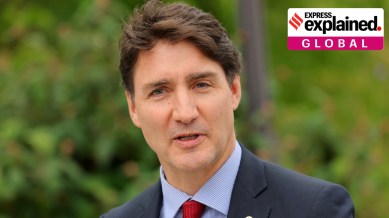How Canada’s new ‘reducing low-wage, temporary workers’ policy may impact Indians
A major portion of Canada’s temporary foreign workers hail from India, specifically Punjab. Here is how a policy shift may impact them

Canada Prime Minister Justin Trudeau on Monday (August 26) announced that Canada is “reducing the number of low-wage, temporary foreign workers” in the country.
This decision reflects a recent policy shift. Previously, the Canadian government had indicated that it plans to bring down the number of such workers in Canada to 5 per cent of the population in the next three years, as against 6.2 per cent in 2023.
Who is likely to be impacted by this move? And what are its larger implications?
Who are these “temporary workers” in Canada?
These include many different categories of individuals.
First are those on temporary work visas. Such individuals come to Canada for a fixed period, say two years, to work in jobs that typically pay between CAD 13-19 per hour (roughly Rs 800-1,200 per hour)..
Second are international students. After completing their studies, many students remain in Canada on one to three year work visas, during which time they apply for Permanent Residency (PR). Students also work (although there are restrictions regarding this) during their studies.
Third are those with Spouse Open Work Permits. Many international students bring their spouses to Canada, who work low-wage jobs under this permit.
Fourth include workers under Labour Market Impact Assessment or LMIA contracts. LMIA allows employers to hire foreign workers when they cannot find Canadians to fill openings.
Arrivals under special humanitarian pathways such as CUAET (Canada-Ukraine Authorization for Emergency Travel) and asylum-seekers, and participants of reciprocal youth programmes which also allow Canadians to work in other countries are also considered temporary workers.
How will Canada’s policy of “reducing” such workers impact Indians?
This policy shift might have a significant impact on Indians, who, till last year comprised around 40 per cent of Canada’s international student population. This would especially impact those from Punjab — more than 50 per cent of Indian arrivals in Canada come from the state, including students, their spouses, and other low wage workers. Restrictions on temporary workers would limit opportunities for these individuals, affecting their income and future prospects.
In fact, until last year, there were no caps on the number of international students that Canada would admit, or on the issuance of open SOPWs. Restrictions have since been imposed, and Trudeau’s latest remarks only re-emphasis the policy shift which could adversely impact Indians looking at Canada as a migration destination.
In a previous statement, Mark Miller, Canada’s Minister of Immigration, Refugees, and Citizenship in Canada said that there has been a “sharp increase” in the volume of temporary residents entering in Canada in recent years, with temporary workers taking on crucial roles in industries such as construction, early childhood education, and healthcare.
That said, he also emphasised on the need to make the system more efficient by ensuring a pathway to PR. Some experts take this as a potential silver lining of the policy.
“The policy could go in two directions. Canada has already taken the first step towards restricting new entry of temporary workers by closing the SOWP in a majority of undergraduate courses, and not renewing or extending work visas for those already in Canada,” Gurpreet Singh, a study-abroad consultant specialising in Canada, told The Indian Express.
“Alternatively, Canada might provide more opportunities for temporary workers to become permanent residents, integrating them more fully into the Canadian economy,” he said.
With elections coming up next year, a number of political and economic considerations might determine which route Canada takes, experts feel.